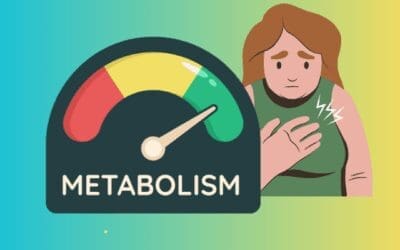Let’s rewind to that time you absolutely crushed it at the gym. You conquered that high-intensity interval training (HIIT) class, feeling like a total fitness rockstar. Endorphins were pumping, and you were ready to take on the world. But then, reality hit. The next day, every muscle in your body screamed in protest. You felt sluggish, demotivated, and maybe even a smidge resentful towards exercise.
This experience, my friend, could be a classic case of overtraining. It happens to the best of us, especially as we hit our 40s and our bodies don’t quite bounce back as quickly as they used to.

Overtraining: Why “More” Isn’t Always Better After 40
Overtraining simply means pushing yourself too hard in your workouts, exceeding your body’s ability to recover properly. It’s like constantly revving your car engine without ever letting it cool down – eventually, something will break.
For people over 40, overtraining can be particularly risky. Our bodies naturally become less efficient at recovery as we age. This means that what might have been a perfectly manageable workout in your 20s could lead to injury, fatigue, and even burnout in your 40s.
The good news is that overtraining is completely preventable! By listening to your body and incorporating smart strategies into your routine, you can stay active, reach your fitness goals, and feel fantastic well into your golden years.
In the next sections, we’ll delve into the signs and symptoms of overtraining, explore science-backed strategies to prevent it, and discover tips to keep your workouts enjoyable and motivating over 40. Let’s conquer your workouts, not overdo them!
Understanding Overtraining After 40

What is Overtraining?
Overtraining boils down to this: pushing yourself too hard in your workouts, exceeding your body’s ability to repair and rebuild itself. It’s like constantly training for a marathon without ever taking a rest day. Imagine yourself lifting weights – those tiny microscopic tears in your muscles are what lead to muscle growth as your body repairs them. But if you keep lifting heavier and heavier weights without giving your muscles a chance to recover, those tears become full-blown injuries.
Normal Muscle Fatigue vs. Overtraining
So, how do you know the difference between normal muscle soreness and the warning signs of overtraining? Here’s the key: muscle soreness after a tough workout is usually temporary and fades within a day or two. This is your body’s natural response to exercise, and it’s actually a good sign – it means your muscles are adapting and getting stronger.
Signs and Symptoms of Overtraining:
Overtraining, however, lingers. Here are some red flags to watch out for, especially for people over 40:
- Decreased performance: You used to effortlessly crank out 10 reps of squats, but now you struggle with 5.
- Persistent fatigue: You feel wiped out all the time, even after a good night’s sleep.
- Increased injuries: You’re constantly dealing with aches, pains, and nagging injuries.
- Sleep problems: You have trouble falling asleep or staying asleep at night.
- Mood swings: You feel irritable, anxious, or even depressed.
- Loss of appetite: You have no interest in eating healthy, or you’re losing weight unintentionally.
- Decreased motivation: The thought of hitting the gym fills you with dread.
Why Overtraining is More Common After 40
As we age, our bodies become less efficient at recovery. Here’s the science behind it:
- Decreased testosterone: Testosterone plays a crucial role in muscle repair. Unfortunately, testosterone levels naturally decline with age, making it harder to rebuild muscle after workouts.
- Slower metabolism: Our bodies burn calories less efficiently as we get older, making it easier to overeat and hinder recovery.
- Increased inflammation: Chronic low-grade inflammation becomes more common with age, which can further slow down recovery and increase the risk of injuries.
By understanding these age-related changes, we can adjust our workouts and prioritize recovery to keep ourselves healthy and motivated.
Preventing Overtraining: Your Roadmap to Fitness Success After 40

Listen to Your Body
Your body is your ultimate workout buddy – listen to its whispers before it screams! Rest and recovery days are not badges of dishonor but essential for rebuilding muscle and preventing overtraining.
Aim for at least one rest day per week, and consider incorporating active recovery activities on those days. Think gentle yoga, swimming, or a brisk walk – these activities keep your blood flowing and aid recovery without pushing your body too hard.
Smart Training: Quality Over Quantity
Forget the “go big or go home” mentality. Proper form and technique are far more important than lifting the heaviest weights or doing endless repetitions. Lifting weights that are too heavy can lead to injury, and excessive reps can hinder your progress.
Focus on controlled movements and ensure you’re targeting the right muscle groups. Don’t be afraid to lower the weight if your form falters – it’s better to do a few exercises correctly than risk injury with heavier weights.
Periodization: Structure for Success
Think of periodization as a roadmap for your workouts. It involves strategically planning different training phases throughout your program to avoid plateaus and prevent overtraining. For example, you might focus on building strength in one phase, followed by a phase dedicated to endurance, then a phase focused on power.
Consulting a certified personal trainer can help you design a personalized periodization plan, but even a basic understanding can be beneficial. Simply consider varying your workouts to keep your body challenged and prevent boredom.
Variety is Key
Don’t get stuck in a fitness rut! Incorporate different types of exercise into your routine, such as cardio (think brisk walking, biking, swimming), strength training (lifting weights, bodyweight exercises), and flexibility work (yoga, Pilates). This keeps your workouts interesting, challenges different muscle groups, and helps prevent injuries.
Prioritize Sleep
Sleep is your body’s magic recovery potion. Aim for 7-8 hours of quality sleep each night. Create a relaxing bedtime routine, invest in blackout curtains, and avoid screens before bed.
Adequate sleep allows your body to repair muscle tissue, boost your immune system, and improve overall health.
Fuel Your Body for Success
Think of food as fuel for your fitness journey. A balanced diet rich in fruits, vegetables, whole grains, and lean protein provides your body with the nutrients it needs to recover and perform optimally.
While consulting a registered dietitian can offer personalized recommendations, some general principles can benefit most people over 40. Focus on whole, unprocessed foods, limit sugary drinks and unhealthy fats, and stay hydrated throughout the day.
Manage Stress
Stress is a sneaky culprit that can contribute to overtraining.
When you’re stressed, your body releases cortisol, a hormone that can break down muscle tissue.
Find healthy ways to manage stress, such as meditation, deep breathing exercises, spending time in nature, or listening to calming music. Even a few minutes of stress management can make a big difference.
Listen to Your Limits
Pushing yourself is great, but pushing yourself to the point of injury or exhaustion is counterproductive.
Be honest with yourself about your limitations.
Don’t be afraid to modify exercises, take breaks when needed, or skip a workout if you’re feeling under the weather.
Remember, consistency is key to long-term fitness success, and that includes listening to your body’s signals.
Don’t Be Afraid to Ask for Help
Seeking guidance from a certified personal trainer or healthcare professional isn’t a sign of weakness – it’s a sign of proactiveness!
A good trainer can help you design safe and effective workouts, ensure proper form, and adjust your program based on your progress and goals. Don’t hesitate to ask questions and leverage their expertise to optimize your fitness journey.
Staying Motivated After 40
Staying motivated after 40 can be a challenge, but it’s definitely achievable! Here are some tips to keep your fitness journey exciting and prevent boredom.
Find an Exercise Buddy
Exercising with a friend or joining a fitness class is a fantastic way to stay motivated. Having a workout buddy creates a sense of accountability – you’re less likely to skip a session if someone is counting on you. Plus, it adds a social element to your workouts, making them more enjoyable. Group fitness classes offer a fun and dynamic atmosphere, pushing you to work harder and providing a sense of community.
Set Realistic Goals and Celebrate Every Milestone
Don’t overwhelm yourself with unrealistic goals like running a marathon in a month. Instead, set small, achievable fitness goals. This could be anything from adding five more pushups to your routine to finally mastering that yoga pose you’ve been struggling with. Celebrating even small victories keeps you motivated and shows you’re making progress.
Track Your Progress
Tracking your progress is a powerful motivator. Keeping a fitness journal or using a fitness tracker allows you to visually see your improvements, from lifting heavier weights to running longer distances. Witnessing your progress is a fantastic way to stay motivated and inspired to keep pushing yourself.
Find Your Fitness Joy
Exercise shouldn’t feel like a chore! Explore different fitness activities and find something you genuinely enjoy. Maybe it’s dancing to your favorite tunes, swimming laps in the pool, or exploring nature with a brisk hike. When you truly enjoy your workouts, you’re more likely to stick with them in the long run. So, ditch the activities you dread and embrace the ones that spark joy – your body and mind will thank you for it!
Conclusion: Conquer Workouts, Not Overtraining
Remember, overtraining is a foe we can easily conquer! By listening to your body and incorporating these key strategies, you can transform your workouts into effective and enjoyable experiences:
- Prioritize rest and recovery – rest days are your allies, not enemies.
- Focus on quality over quantity – proper form is key to preventing injury.
- Embrace variety – keep your workouts interesting with different types of exercise.
- Make sleep a non-negotiable – aim for 7-8 hours of quality sleep each night.
- Fuel your body for success – a balanced diet is your best performance booster.
- Manage stress – find healthy strategies to keep stress at bay.
- Listen to your limits – don’t be afraid to modify exercises or take breaks.
- Seek guidance when needed – a personal trainer can help you optimize your program.
The good news is, with a little planning and self-awareness, you can maintain a safe and effective fitness routine well into your 40s and beyond. So ditch the fear of overtraining, embrace these smart strategies, and get ready to conquer your workouts – and your fitness goals! Remember, a healthy and active lifestyle is a lifelong journey, and you have the power to make it an enjoyable one.






